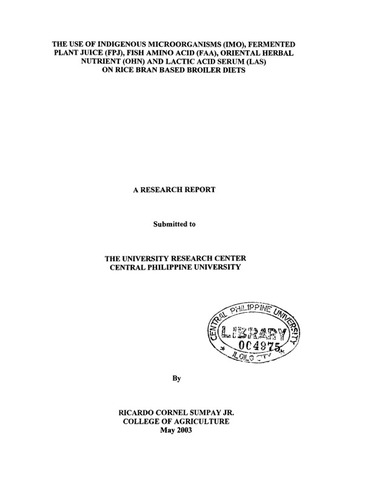Ipakita ang simpleng tala ng item
The use of indigenous microorganisms (IMO), fermented plant juice (FPJ), fish amino acid (FAA), oriental herbal nutrient (OHN) and lactic acid serum (LAS) on rice bran-based broiler diets
| dc.contributor.author | Sumpay, Ricardo C. Jr. | |
| dc.date.accessioned | 2022-02-23T00:38:03Z | |
| dc.date.available | 2022-02-23T00:38:03Z | |
| dc.date.issued | 2003-05 | |
| dc.identifier.citation | Sumpay, R. C. , Jr. (2003). The use of indigenous microorganisms (IMO), fermented plant juice (FPJ), fish amino acid (FAA), oriental herbal nutrient (OHN) and lactic acid serum (LAS) on rice bran-based broiler diets (Research report). Jaro, Iloilo City: University Research Center, Central Philippine University. | en_US |
| dc.identifier.uri | https://hdl.handle.net/20.500.12852/1952 | |
| dc.description | Abstract only Full text available | en_US |
| dc.description.abstract | The study was conducted from December 20, 2002 to January 21, 2003 at Jamandre Poultry Farm, Bongco, Pototan, Iloilo to evaluate the feeding value of indigenous microorganisms (IMO), fermented fruit juice (FPJ), fish amino acid (FAA), oriental herbal nutrient (OHN), lactic acid serum (LAS) and their combined mixture on the growing, finishing, carcass quality and economic returns of arbor acre broilers on rice bran-based diets. One hundred sixty-eight chicks were divided equally and assigned randomly into seven treatments with three replications. The treatments were broiler diet A with commercial feed ration (0 percent concoction level) and diets B, C, D, E, F, and G with 1 percent level of IMO, FPJ, FAA, OHN, LAS and their combined mixture on rice bran-based broiler ration, respectively. The result of the study showed that broilers fed with commercial feed without concoction consumed more feeds and were relatively higher in liveweight gain, carcass recovered and returned over feed, chicks and medicine cost as compared with those fed with IMO, FPJ, OHN, combined mixture, FAA, and LAS. It was only among broilers fed with oriental herbal oriental where the performance of broilers fed with the commercial ration was significantly (P<0.01) comparable in the amount of feed consumed and liveweight gained. It was also observed that even if it is expensive to fed broilers on a purely commercial ration without concoction, a higher return over fed, medicine and chick cost was noted, as compared with those birds fed with IMO, FPJ, OHN, combined mixture, FAA, and LAS by P12.25, P14.22, P14.41, P15.87, P18.53, and P24.59 per bird on rice bran-based broiler ration, respectively. | en_US |
| dc.description.sponsorship | University Research Center | en_US |
| dc.format.extent | 30 leaves | en_US |
| dc.language.iso | en | en_US |
| dc.publisher | University Research Center | en_US |
| dc.subject.ddc | GSL 630.72 Su67 | en_US |
| dc.subject.lcsh | Broilers (Chickens) | en_US |
| dc.subject.lcsh | Broilers (Chickens)--Feeding and feeds | en_US |
| dc.subject.lcsh | Chickens--Feeding and feeds | en_US |
| dc.subject.lcsh | Amino acids | en_US |
| dc.subject.lcsh | Amino acids in animal nutrition | en_US |
| dc.subject.lcsh | Microorganisms | en_US |
| dc.subject.lcsh | Plant extracts | en_US |
| dc.subject.lcsh | Herbs | en_US |
| dc.subject.lcsh | Plant nutrients | en_US |
| dc.subject.lcsh | Lactic acid | en_US |
| dc.subject.lcsh | Rice bran | en_US |
| dc.subject.lcsh | Rice bran as feed | en_US |
| dc.title | The use of indigenous microorganisms (IMO), fermented plant juice (FPJ), fish amino acid (FAA), oriental herbal nutrient (OHN) and lactic acid serum (LAS) on rice bran-based broiler diets | en_US |
| dc.type | Technical Report | en_US |
| dcterms.accessRights | Limited public access | en_US |
| dc.description.bibliographicalreferences | Includes bibliographical references | en_US |
Mga file sa item na ito
Lumilitaw ang item na ito sa mga sumusunod na (mga) Koleksyon
-
Research reports [167]


